Fosi Audio DS2
Fosi Audio DS2: High-Power Portability in a Compact Package
The Fosi Audio DS2 is a portable USB dongle DAC/amp that combines clean design with impressive performance.
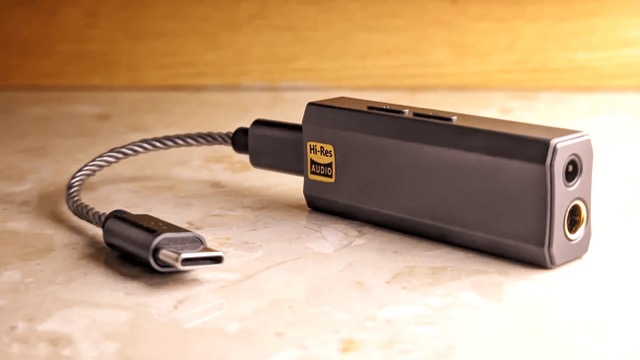
Note: I would like to thank Fosi Audio for sending me DS2 not for this review but as a gift for assisting them with a research survey. But if you are interested in more information about the DS2 check it the details: here
But let’s see what you get with the DS2:
Unboxing Experience and Box Contents
The DS2 comes in straightforward packaging that reflects its minimalist design philosophy.
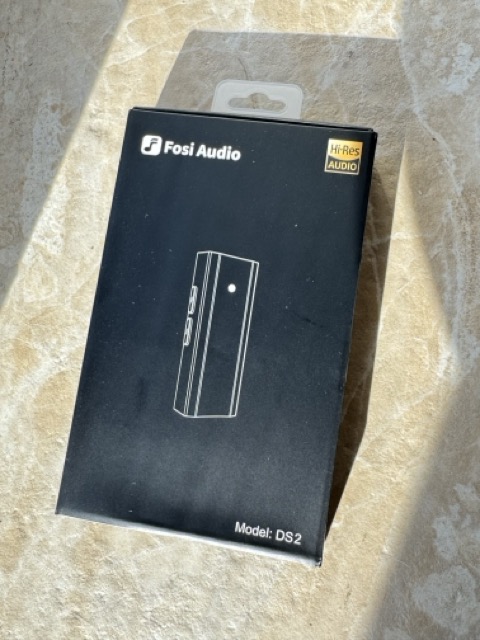 Open the box:
Open the box:
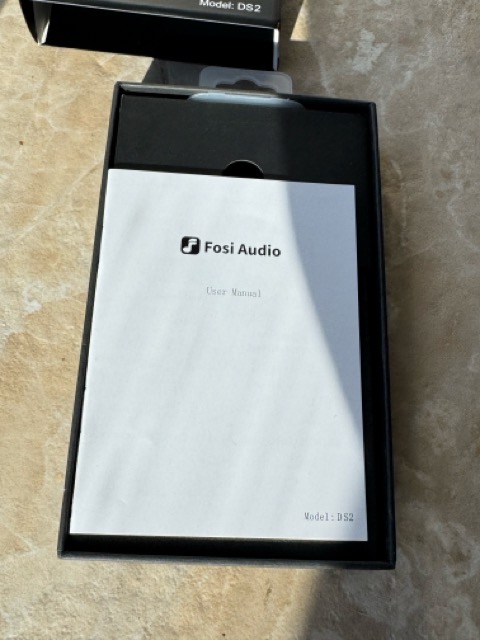
Inside the box, you’ll find:
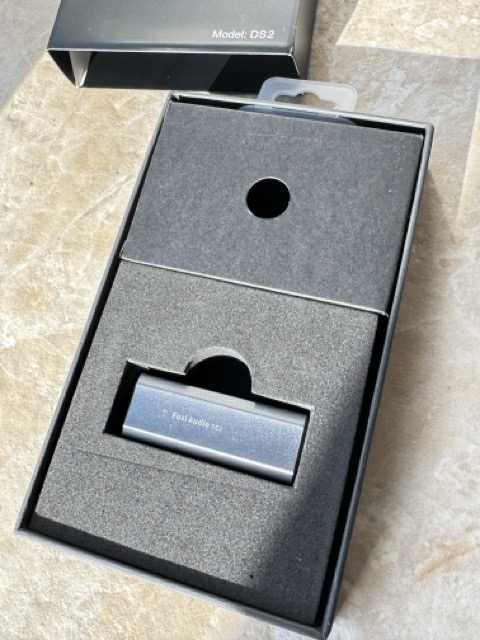
Finally, here is everything you get in the box:
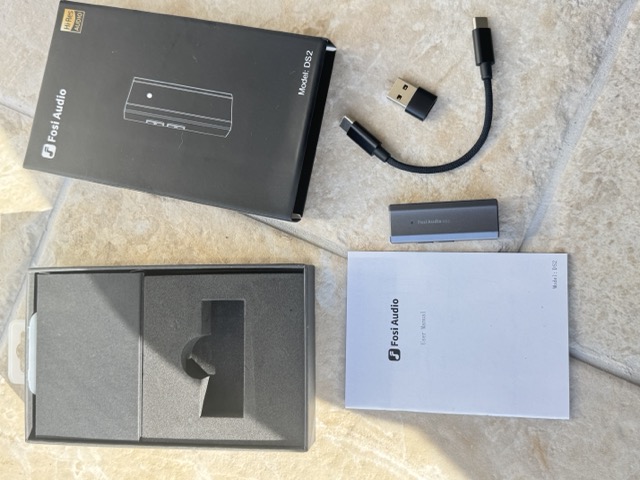
- Fosi Audio DS2 dongle
- USB-C to USB-C cable
- USB-C to USB-A adapter
- User manual and warranty card
The inclusion of a USB-A adapter is a thoughtful touch, ensuring compatibility with a wider range of devices.
Design and Build Quality
The DS2 boasts an understated design, with a robust aluminum chassis that feels premium and durable. The clean,
functional aesthetic makes it a perfect match for any setup.
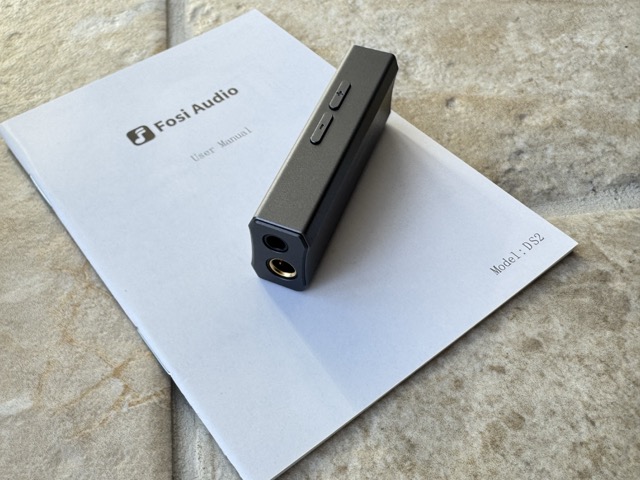 At just under 20g, it’s lightweight and portable, ideal for
on-the-go audiophiles:
At just under 20g, it’s lightweight and portable, ideal for
on-the-go audiophiles:
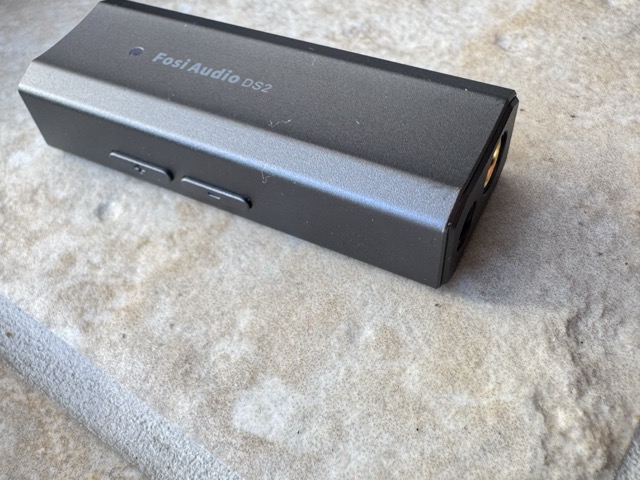
Both the 3.5mm and 4.4mm outputs are well-constructed, providing a secure connection for headphones. The DS2 features a
small status LED that changes color to indicate sample rate and playback type (PCM or DSD), adding a functional touch
without cluttering the design.
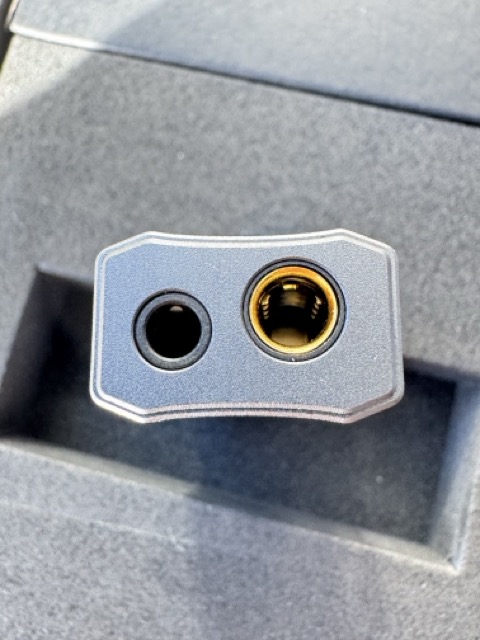
Key Features
Dual DAC Architecture for Superior Audio Quality
The DS2 is powered by dual CS43131 DAC chips, delivering excellent dynamic range and low distortion. This architecture ensures precise channel separation and transparency, making it an excellent choice for audiophiles who prioritize uncolored, accurate sound reproduction.
4.4mm Balanced Output for Enhanced Power
With its balanced 4.4mm output, the DS2 provides up to 510mW of power at 32Ω, capable of driving most headphones with ease. The single-ended 3.5mm output is no slouch either, offering a respectable 130mW at 32Ω.
Cross-Platform Compatibility
The DS2 supports plug-and-play functionality across all major platforms, including Windows, macOS, Android, and iOS ( with an appropriate adapter for Lightning devices). It also supports high-resolution formats up to PCM 384kHz and DSD256, ensuring you can enjoy your music in its highest fidelity.
Sound Impressions
The Fosi Audio DS2 delivers a neutral, transparent sound signature with no noticeable coloration. This makes it an excellent choice for purists who value accurate reproduction.
Bass
The bass is tight, controlled, and well-extended. Tracks like “Another One Bites the Dust” by Queen showcase the DS2’s ability to deliver punchy, precise low frequencies without overpowering the rest of the spectrum.
Midrange
The midrange is detailed and natural, with a pleasing sense of clarity and warmth. Vocals and instruments are rendered with excellent separation, making tracks like “Hello” by Adele an immersive experience.
Treble
The treble is smooth and detailed, avoiding harshness or sibilance. High-frequency details in tracks like “Take Five” by The Dave Brubeck Quartet are presented with air and sparkle, enhancing the overall listening experience.
Practical Measurements and Comparisons
Why I am calling this a ‘practical measurement’ section?
DAC are like transparent windows
You will often see reviews on head-fi (and other websites) talking about the subjective differences between different headphone DAC amps, one having a better bass response or another focusing on the midrange while a third might give you a more detailed treble and this was certainly the case in this market as recent as 3 years ago. And especially the case at both the cheaper end of the market (as the technology was not as matured) but it can also for the very high end where manufacturers want to distinguish their devices with unique sound signature.
But in my opinion, DAC and Amplifiers should not (by design) change the sound signature, though obviously some implementations are better than others and some implementations (like Tube amps) will deliberately ‘colour’ your sound (like a stained-glass window). Older cheaper designs would also affect the extremes of your sound (the sub-bass) or poor filter implementations (near 20,000Hz) - maybe like glass that has ‘blurry’ or ‘frosted’ edges but then crystal clear in the middle.
I believe the best DAC and Amplifiers should be perfectly transparent and let your music be ‘seen’ perfectly clear by your headphones and IEMS (and Speakers), unless you choose some EQ to your preference.
Measurements of an old DAC compared to a modern one
Few manufacturers would publish their measurements but as an example I did find during my recent review of the FiiO KA15 some earlier measurements of the FiiO K3, for comparison and the difference I think perfectly illustrate the point that the industry has moved on. Below is the FiiO DAC K3 from 2019 compared to the latest KA15:
| K3 - roll off at extremes | KA15 - perfectly transparent |
|---|---|
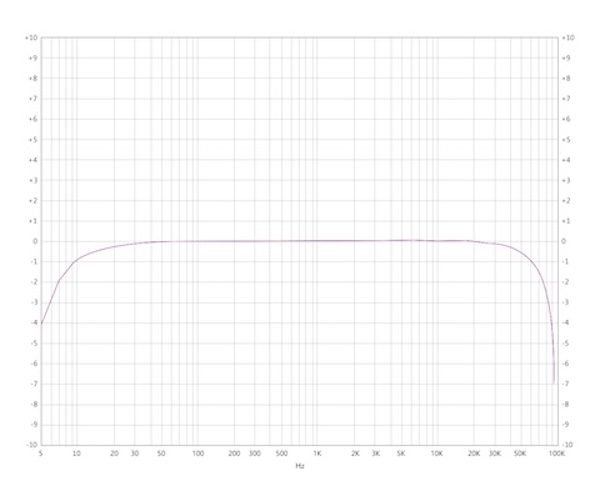 |
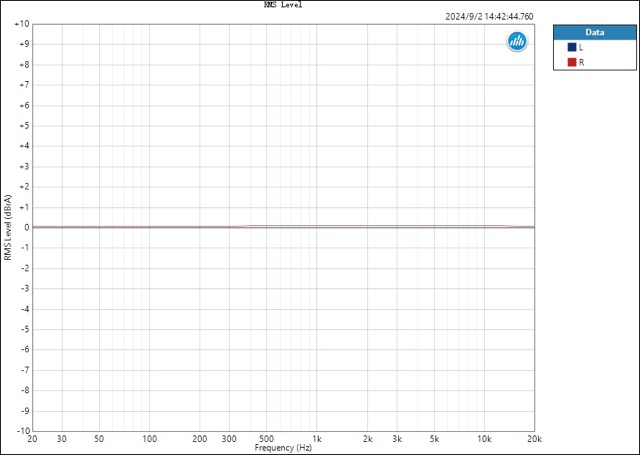 |
While from 20-20,000Hz the K3 was a mostly flat it does roll off while a modern DAC will (should) be transparently ‘flat’.
Selection of a Headphone for ‘Practical Measurement’
Rather than compare DAC Amp SINAD charts, I thought for this review it might be more fun to see how well does this DAC Amp (and a few other portable DAC amps) perform when driving a real headphone to loud ‘90+ dbSPL’ volumes and then measure the output from that the headphone to see if it is still transparent. This is to remove most of that typical uncertainty that I read when people just read DAC or Amplifier measurements (i.e. ‘but how will it perform with my XXXX headphone’ ).
So over at AudioScienceReview Amir has been putting together an interesting graph of how hard it is to drive any headphone that he has measured, and it is becoming a very extensive and interesting list covering most of the ’normal’ headphones (and some very expensive ‘high end’ headphones). Here is the latest version of that chart:
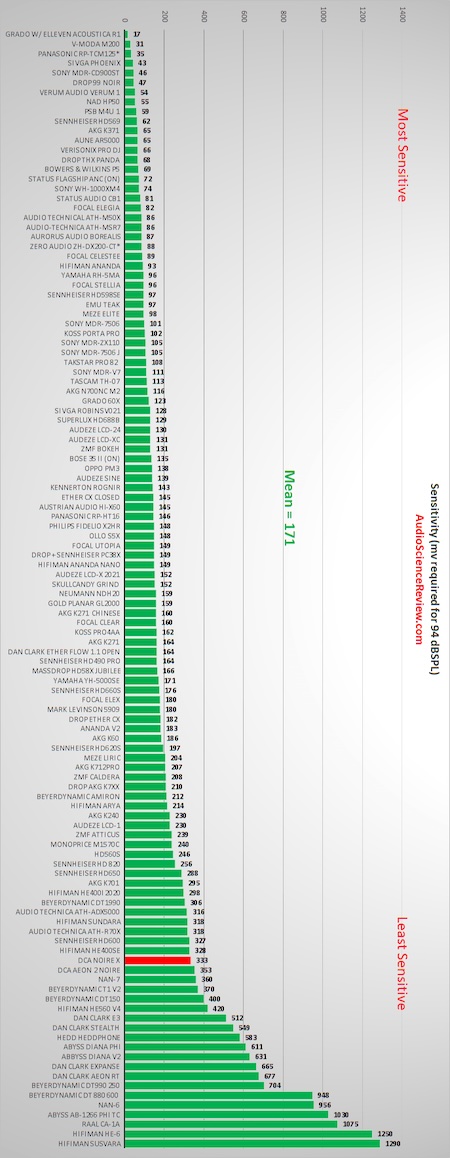
For those interested here is the source of this version of the list is from his latest: DCA Noire X review
So I thought I should use a headphone from the bottom end of this chart as a good ’test’ of these DACs, so I picked
the Hifiman Sundara (as I am about to publish a review of that headphone). So here is that section of the list zoomed:
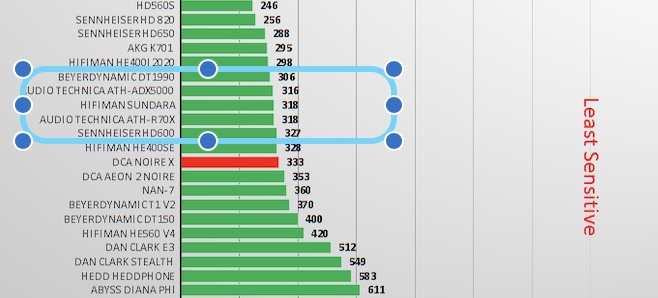
As you can hopefully see I thought the Hifiman Sundara was a good ‘challenging’ part of this chart. So lets see how the Macaron does. But first I thought I should measure the Sundara with various Headphone DACs to compare if there is any ’tonality’ differences:
Hifiman Sundara FR with various DACs
So in this test I measured the Sundara using my KB501X softear pinna and a 711 clone coupler and I decided
to ‘volume level’ the output measured (as close as I could) with the various DAC Amps:
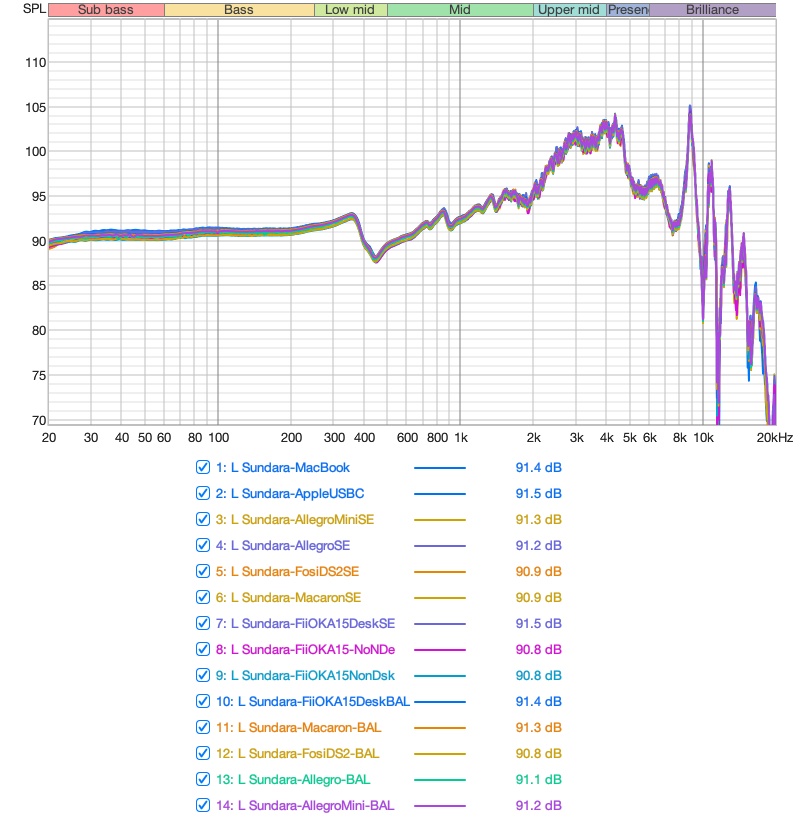
As you can hopefully see each one of the devices used produced the same result (i.e. they were all transparent at 90+ dbSPL). I even started using my Macbook Pro own headphone jack, then the Apple usb-c, and then I followed up with both the single ended and then the balanced output of various dongles.
Here a photo of the dongles (including the Macaron) that I used in this measurement (though I didn’t
measure the Qudelik 4K and the FiiO KA17 in this particular comparison):
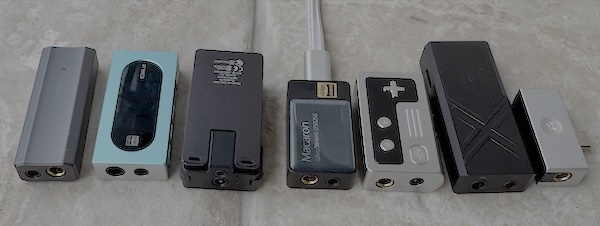
So in this photo the ones I used are Fosi Audio DS2, FiiO KA15, iBasso Jr Macaron, Kiwiears Allegro and the Kiwiears Allegro Mini on the right-hand side of this photo.
So the point of this is each of these devices can drive a ‘hard to drive’ headphone but what ‘headroom’ do they leave for that track that has high dynamic range or for applying EQ filters (often needing an extra 10dbSPL).
To capture this I used my Macbook Pro to ‘record’ what volume was needed to drive each device to this ‘volume matched’ level (except with the Macaron I had to use Macaron own volume buttons and I did not enable the high gain or turbo modes within the iBasso UAC Companion application as this was the default).
I believe you should always have some headroom when driving headphones so having more volume available, the better but which of these devices has ’enough’ for your use-case (on this relatively hard to drive headphone), so low volume is better:
| Device | Volume out of 100 | Comment |
|---|---|---|
| Macbook Pro | 83.6 | Good enough but a bit more headroom is needed |
| Apple usb-c | 90.2 | Barely enough - I would not recommend for Sundara |
| Kiwiears Allegro Mini SE | 88.4 | Better than apple dongle but still not recommended |
| Kiwiears Allegro Mini BAL | 88.4 | Balanced same as SE on Allegro Mini?? |
| Kiwiears Allegro SE | 70.8 | Uses a ES9028Q2M DAC - good for Sundara but not for |
| devices further down that list | ||
| Kiwiears Allegro BAL | 55.7 | Now this is pretty impressive |
| Fosi Audio DS2 SE | 70.8 | Uses Dual CS43131 also good enough for Sundara |
| Fosi Audio DS2 BAL | 55.7 | Same chipset so similarly impressive result |
| iBasso Jr Macaron | 80 on iBasso VOL | Good enough - Low Gain / Turbo off (so lots of options to enhance) |
| iBasso Jr Macaron BAL | 68 on iBasso VOL | Again easily good enough - Low Gain / Turbo off ( ultimately similar performance to the DS2 and the Allegro ) |
| FiiO KA15 Non Desktop SE | 82.5 | Uses a dual CS43198 with opamps - no headroom? |
| FiiO KA15 Desktop Mode SE | 66.7 | This would but uses more of phone battery |
| FiiO KA15 Non Desktop BAL | 65.3 | Also good enough for PEQ + Headroom |
| FiiO KA15 Desktop Mode BAL | 51.4 | Excellent - could tackle more devices on that list |
I think it’s pretty impressive that all these devices could drive the Sundara to a pretty loud 90+ dbSPL, but what does each cost:
| Device | Cost |
|---|---|
| Apple usb-c | $9 |
| Kiwiears Allegro Mini | $24 |
| Kiwiears Allegro | $50.99 |
| Fosi Audio DS2 | $59.99 |
| iBasso Jr Macaron | $49 |
| FiiO KA15 | $109 |
So the KA15 is considerable more expensive but does have a little more power, a screen and PEQ capabilities via a companion application.
Since, the Allegro Mini is really just slightly more powerful than the Apple USB-C dongle it benefits are the conveniences of having both a 3.5mm and 4.4mm and its super compact size.
While the iBasso Jr Macaron is the cheapest of the “dual CS43131” models, it also has a ‘companion’ application and if you are an Android user and for Android users it probably offers the best overall offering. But the Fosi Audio DS2 is a fantastic looking device that also provide excellent price / performance ratio and is my favourite for iPhone users.
Given that all these devices are “transparent” with a relatively ‘hard to drive’ headphone at 90+ dbSPL we are at a golden age for ‘pragmatically’ price portable audio devices.
Distortion Measurements
One thing I did not measure of these DAC’s was the SINAD and distortion but recently Amir over at AudioScienceReview reviewed the DS2 and found it an exceptional DAC from a measurement perspective.
While SINAD doesn’t really tell you anything other than how well it is internall built (assuming the SINAD is over
about 80) it is an impressive result and it currently top of the SINAD charts for portable DACs:
And it worth showing the multi-tone results:
Rating
The Fosi Audio DS2 delivers a compelling combination of power, transparency, and compatibility with all major platforms (Windows, macOS, Android, and iOS). Its dual outputs (3.5mm single-ended and 4.4mm balanced) ensure it can drive everything from sensitive IEMs to more demanding headphones with ease.
The Fosi Audio DS2 earns a 5-star pragmatic rating for its clean design, platform compatibility, and exceptional power output. At its price point, it represents outstanding value for those seeking a transparent, powerful USB dongle DAC/amp.
Conclusion
The Fosi Audio DS2 is a standout portable DAC/amp, combining high power output, transparency, and platform versatility in a compact, sleek design. Whether you’re driving sensitive IEMs or more demanding over-ear headphones, the DS2 delivers consistent performance without breaking the bank. For audiophiles seeking a reliable, pragmatic solution for portable audio, the DS2 is an easy recommendation.